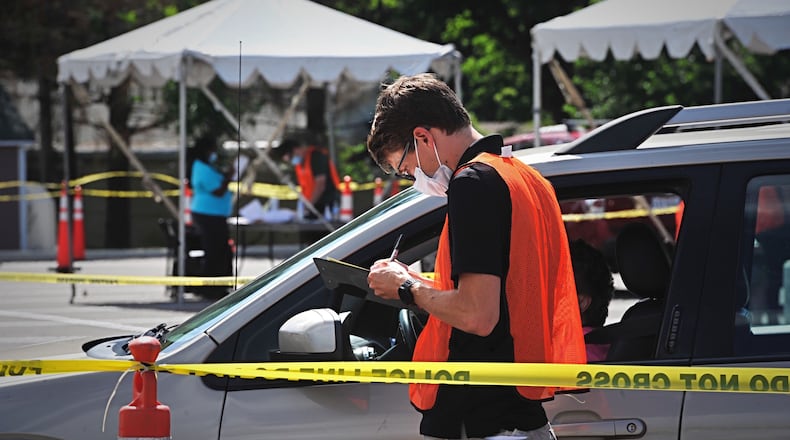Ohio is seeing an “unprecedented" spike in coronavirus hospitalizations as cases continue to surge throughout the state said Dr. Bruce Vanderhoff, incoming Ohio Department of Health Chief Medical Officer.
While the state currently has adequate hospital space, personal protective equipment and medication to treat COVID-19 and other patients, Vanderhoff said there are concerns that if cases continue to rise quickly, hospitals and hospital staff could be overwhelmed in a matter of weeks.
“If we don’t control the spread, we won’t be able to continue caring for the acutely ill without postponing important, but less urgent, care,” he said. “This kind of shift could happen in a matter of weeks if trends don’t change.”
Lofgren said the region is seeing an unprecedented increase in hospitalizations since the beginning of October. As of today, there are more than 670 COVID-19 patients in hospitals in the area. The previous peak prior to this recent surge was 300 patients in July.
Dr. Richard Lofgren of @UC_Health on ZONE 3 hospital capacity: We've had an unprecedented increase in Hospital cases since the beginning of October. We have over 670 patients today, our previous peak was 300 patients in July. This is a whole magnitude higher. pic.twitter.com/F6eyuWPvYF
— Governor Mike DeWine (@GovMikeDeWine) November 9, 2020
“This is a whole magnitude higher,” he said. “If we do again what we did in the early part of fall - adhering to basic principles of social distancing, wearing a mask, washing hands, and not expanding your personal bubble - we can bring the spread of the virus under control.”
Lofgren noted that the recent spike is starting to overwhelm contract tracers. He also said that contract tracers are seeing some issues with people not cooperating with them, which limits health officials.
He believes most of the virus' spread is the result of people dropping their guard and letting more people into their bubble, not wearing masks or not social distancing anymore.
Dr. Andy Thomas of The Ohio State University Wexner Medical Center said Zone 2, which includes central and southeast Ohio, could be two or three weeks out from crowding out non-COVID-19 care.
In Zone 1, or northern Ohio, more caregivers are coming down with the virus, said Dr. Robert Wyllie of the Cleveland Clinic.
“It’s not because they’re catching it in the hospital,” he said. “It’s because they’re catching it in the community, so we need everyone to double down.”
Wyllie stressed that now is not the time to give up. He asked that people re-evaluate and monitor their personal behavior.
“We’re asking for everyone’s help,” Vanderhoff said.
When asked if Ohio could see lockdowns and other previous mandates return, Lofgren noted that officials know a lot more about the virus and that things such as masks and social distancing work.
“We’re asking people to come together and do this,” he said. “This is the first step.”
More than 150 hospitalizations were reported in Ohio Monday, just below the state’s 21-day average of 166. There are 2,533 COVID-19 patients in hospitals across the state, up by more than 1,000 than the 1,456 patients reported on Oct. 27, according to ODH.
In southwest Ohio, there were 671 hospitalized coronavirus patients on Monday, with 163 in the ICU and97 on ventilators. COVID-19 patients account for 9.76% of the region’s hospital beds, with 2,018 beds, or 29.34%, open.
The state added 34 ICU admissions to its total. There have been 4,047 ICU admissions reported in Ohio throughout the pandemic.
Ohio added 4,706 coronavirus cases Monday, bringing its total to 254,974, according to the ODH. Deaths increased by seven for a total of 5,524.
Last week, Ohio broke its record for daily cases multiple times, setting its most recent record with more than 5,500 cases on Saturday. The state reported more than 4,000 cases in 24 hours for the first time on Nov. 3 and hasn’t dropped below the 4,000 mark since.
About the Author

